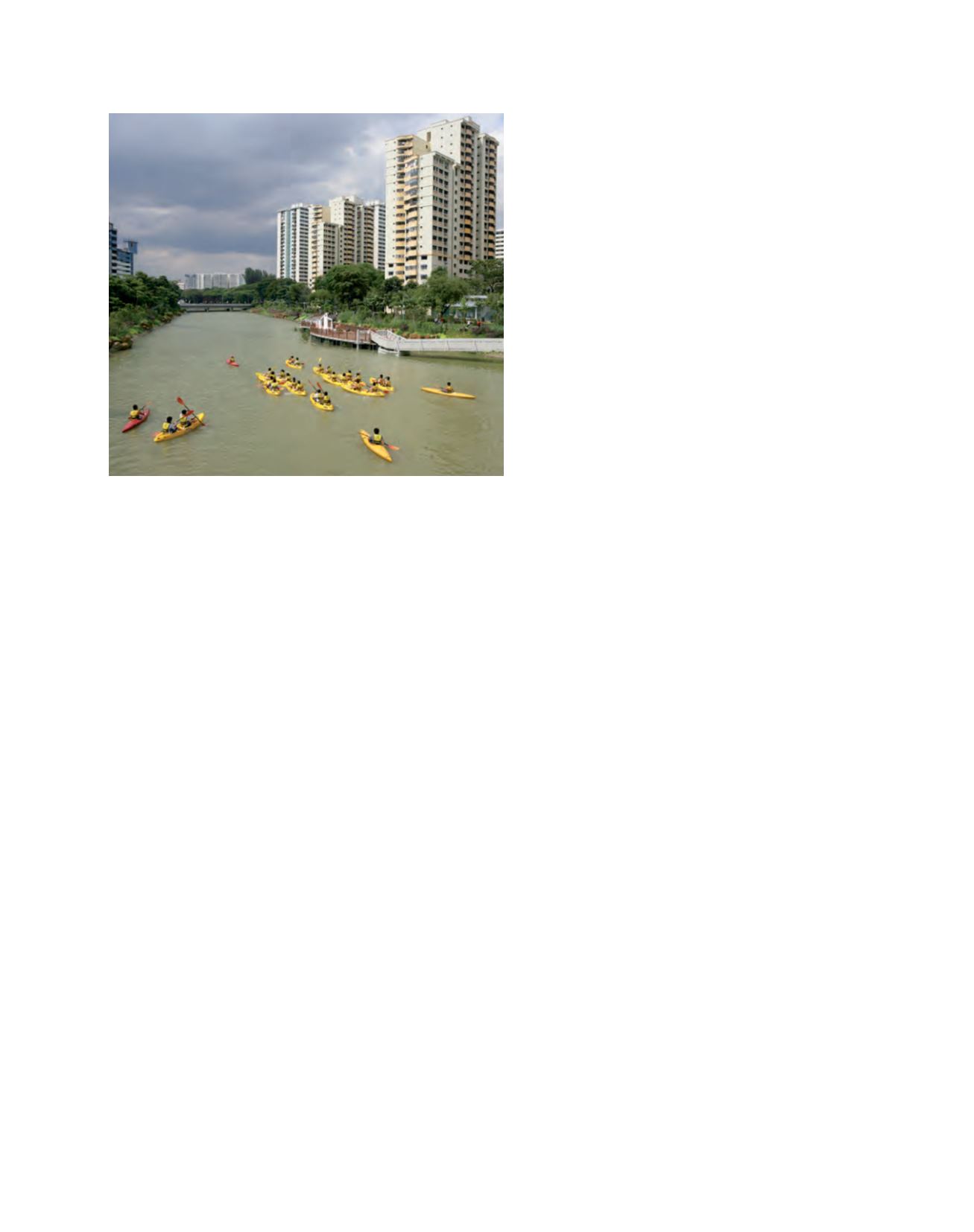

[
] 245
A
daptation
and
M
itigation
S
trategies
emphasizes that water is a scarce and precious resource from the
very first drop. The tariff and WCT are increased for households
that consume more than 40 cubic metres per month to encourage
conservation.
Mandatory conservation measures include low capacity flushing
cisterns, constant flow regulators, self-closing delayed action taps
and maximum allowable flow rates. Voluntary measures include
community-driven public education programmes such as ‘Water
Efficient Homes’ and the ‘10 Litre Challenge’. Under the programme,
DIY water saving kits consisting of flow resistors, cistern bags and
leaflets were supplied to residents free of charge.
Domestic water consumption reduced from a peak of 176 litres per
person per day in 1994 to 157 litres in 2007. PUB expects to lower
this to 155 by 2012. Annual water demand growth rate since 1995
has been kept low at about 1.1 per cent, despite GDP and popula-
tion growth of 5.1 per cent and 2.2 per cent per annum respectively.
Active, Beautiful, Clean Waters
Beyond conservation, PUB has embarked on efforts to get people to
value and enjoy its ‘blue assets’ through the Active, Beautiful, Clean
Waters programme. Singapore has 32 rivers and will eventually have
17 reservoirs. In addition to source control and mitigation measures
to ensure good water quality, PUB also takes a community approach
by transforming concrete canals into beautiful and vibrant spaces for
recreational activities.
To gain building industry support, PUB developed a set of design
guidelines providing instructions on the design of water sensitive land-
scaping features such as bio-swales and rainwater gardens. Such features
soften harsh concrete canal edges while removing nutrients in the storm
water. Peak flows in the drains and waterways are also reduced as water
is retained for a longer time before reaching the waterways.
Leveraging on innovation and technology
A small country with no natural resources, Singapore has always
used technology as part of its nation-building efforts. As such, there
have been heavy investments in technology to seek
solutions for its water needs.
Seawater desalination is still costly, being over three
times more energy intensive per cubic metre than
NEWater or conventional treatment. With rising oil
prices, this will be accentuated. Future development
in desalination lies in reducing energy consumption.
PUB is exploring various alternatives such as membrane
distillation and variable salinity plants, which treat both
freshwater and seawater. The Singapore Government
has challenged the research community to produce
viable alternatives that desalinate seawater at 50 per
cent more energy efficiency than current technologies.
It attracted local and overseas research companies, and
Siemens Water Technologies clinched the deal with a
novel electrically driven desalination process. Siemens
received SGD4 million (USD2.7 million) worth of funds
to investigate the concept. If successful, it would benefit
other countries as well as Singapore.
Flooding and sea-level rise
In the 1960s and 1970s, floods were common and wide-
spread, especially in the city area. In 1978, Singapore
experienced its most severe flood when 512 millimetres
of rain was recorded over 24 hours, coinciding with a
high spring tide. Roads were submerged under a metre
of water. Seven people died and more than 1,000 were
evacuated from their homes. Since 1973, over USD1.3
billion has been spent to construct new drains and
canals. Flood-prone areas have been reduced from
3,200 hectares in the 1970s to 124 hectares today, even
as urbanized areas have increased.
Higher sea levels due to climate change will pose a
challenge for drainage. As much of Singapore’s coast
is reclaimed land, in 1991 PUB insisted that reclaimed
land is constructed at least 125 centimetres above the
highest recorded tide level. This has put Singapore in
a stronger position, as IPCC AR4 projects a maximum
sea-level rise of 59 centimetres. Plans are in place to
ensure that drainage infrastructure can meet the effects
of climate change. The Vulnerability Study will review
drainage design, produce new flood maps and facili-
tate adaptation measures; such as the setting of new
minimum platform levels for developments and land
reclamation, increasing tidal gate height at estuarine
reservoirs, and protection of foreshore and coastal areas
including beaches and mangrove habitats.
Singapore has taken steps to prepare for climate
change. The Four National Taps not only meet long-
term needs, they also mitigate future uncertainties,
as NEWater and desalination are not affected by the
vagaries of weather. The development of NEWater is
even more strategic as it effectively doubles Singapore’s
resources. Conservation and efficient management of
the network will continue to be given high priority to
keep demand growth low. Innovation has played a key
role in developing sustainability and Singapore will
continue to invest heavily in research and new water
technologies.
Transformation of waterways
Image: PUB
















